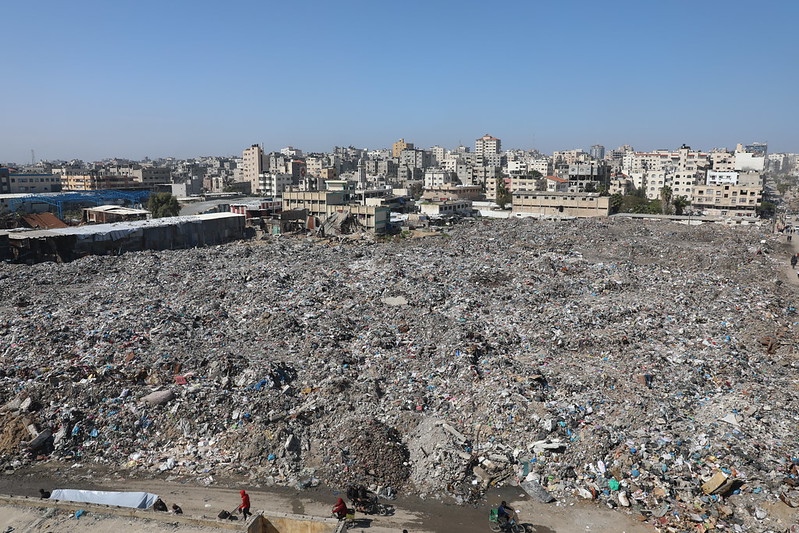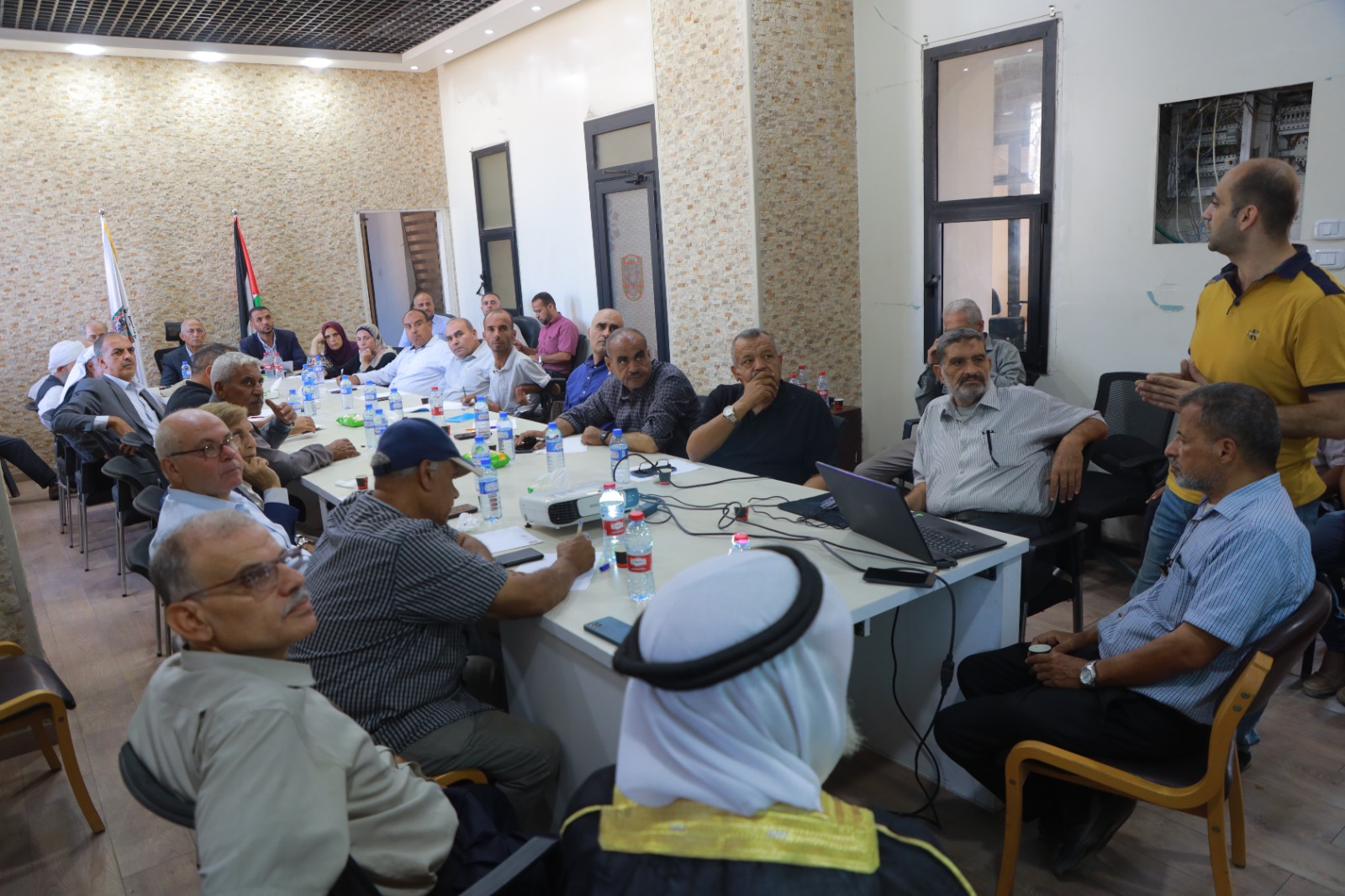
إعلام البلدية:
تشكل مكبات النفايات في قلب المدينة قنبلة وكارثة صحية وبيئية تهدد حياة الإنسان، وتتزايد كميات النفايات يوما بعد يوم حتى وصلت الكمية لأكثر من 175 ألف طن من النفايات تتجمع في مكبين في داخل المدينة هما؛ مكب أرض سوق فراس المطل على شارع عمر المختار، والمكب المؤقت في محطة تجميع النفايات في منطقة اليرموك.
ومع بدء ارتفاع درجات الحرارة تتحلل هذه الكميات الضخمة من النفايات وتشتعل بها النار ذاتيا بفعل مركبات النفايات العضوية والغير عضوية ويخرج منها الدخان الضار والروائح الكريهة، وكذلك يتزايد انتشار الحشرات والقوارض الضارة التي تتسبب بالأمراض.
الاحتلال يمنع
وحول أسباب تجميع النفايات في داخل المدينة أوضح مدير دائرة الصحة والبيئة في البلدية م. أيمن حمودة أن البلدية اضطرت لتجميع النفايات في مكبات داخل المدينة بسبب أن الاحتلال يمنع طواقم البلدية من الوصول للمكب الرئيس في منطقة جحر الديك شرق المدينة منذ بدء العدوان وحرب الإبادة في شهر أكتوبر من العام 2023.
ويضيف أن البلدية اضطرت لتجميع النفايات في مكبات مؤقتة في محطة اليرموك وسوق فراس في وسط المدينة وهي مكبات غير مؤهلة وصغيرة المساحة وتقع في قلب المدينة وتشكل خطراً كبيرا على حياة الإنسان في المدينة.
مرحلة الخطر
بدوره؛ أكد رئيس قسم جمع وترحيل النفايات م. محمد العشي، أن مكب سوق فراس وصل إلى مرحلة الخطر ووصل ارتفاع النفايات إلى 4 أمتار؛ وأن المكب يحتوي على نحو 130 ألف طن من النفايات وأصبح ممتلئا بشكل كبير وقد يؤدي استمرار تجميع النفايات لإغلاق شارع عمر المختار المحاذي للمكب.
وبين أن تجميع النفايات في داخل المدينة يتسبب بالعديد من المخاطر البيئية والصحية لاسيما مع دخول فصل الصيف وارتفاع درجات الحرارة، تصبح العصارة الناتجة عن النفايات أكثر خطرًا وتتزايد سرعة تسربها إلى المياه الجوفية؛ مما يلوث مصادر المياه ويعرض سكان المدينة لمخاطر صحية كبيرة.
مرتع خصب
وأضاف أن هذه المكبات تشكل مرتعا خصبا لانتشار الأمراض بسبب تراكم الحشرات والقوارض الضارة، ويُضاعف حرق النفايات من تلوث الهواء؛ مما يسبب أمراضًا تنفسية وسرطانية، إضافة إلى تضرر الأراضي الزراعية وجعلها غير صالحة للزراعة، مما يؤثر على الإنتاج الزراعي.
وتعمد الاحتلال الإسرائيلي خلال العدوان وحرب الإبادة على استهداف كافة مناحي الحياة في المدينة ومنها البيئة والآليات، حيث تسبب في تدمير نحو 134 آلية لاسيما آليات جمع وترحيل النفايات في المدينة.
وتطالب بلدية غزة المنظمات الدولية بضرورة التدخل العاجل والضغط على الاحتلال للسماح لطواقم البلدية من الوصول للمكب الرئيس في منطقة جحر الديك ومساعدة البلدية في توفير آليات لجمع النفايات.
.
Toxic Smoke and Disease-Carrying Pests: Waste Dumps in the Heart of Gaza City Pose a Grave Threat to Public Health
Waste disposal sites in the heart of Gaza City have become a ticking time bomb, posing a severe environmental and public health hazard. With waste volumes growing daily, over 175,000 metric tons of solid waste have now accumulated in two central dump sites: one at the Firas Market area overlooking Omar Al-Mukhtar Street, and a second at the temporary Yarmouk Waste Transfer Station.
As temperatures rise, these vast mounds of solid waste begin to decompose and frequently ignite spontaneously due to the chemical composition of both organic and inorganic materials. The result is the emission of toxic smoke, pungent odors, and the proliferation of disease-carrying insects and rodents.
Restricted Access Due to Occupation Forces
Engineer Ayman Hammouda, Director of the Health and Environment Department at Gaza Municipality, explained that the accumulation of waste within the city is a direct consequence of Israeli restrictions. Since the onset of the October 2023 military assault, municipal teams have been barred from accessing the main landfill in Juhr Al-Deek, located east of the city.
“As a result,” Hammouda said, “the municipality was forced to establish temporary waste dumps within the city center, specifically in Yarmouk and the Firas Market area. These sites are neither engineered nor suitable for long-term waste storage and pose a serious threat to the health and safety of urban residents.”
Entering a Critical Stage
Engineer Mohammad Al-Ashi, Head of the Solid Waste Collection and Transportation Department, warned that the Firas Market landfill has reached a critical danger level, with waste piles now exceeding four meters in height and containing nearly 130,000 tons of garbage. Continued accumulation threatens to block Omar Al-Mukhtar Street, a key urban artery.
He further noted that with the onset of summer, leachate generation—the toxic liquid produced by decomposing waste—accelerates and poses a significant risk of groundwater contamination. This threatens the city's already limited water resources and exposes residents to serious health hazards.
A Breeding Ground for Disease
“These dump sites have become breeding grounds for epidemics,” Al-Ashi added, citing the surge in insect and rodent populations. Additionally, uncontrolled waste burning has exacerbated air pollution, increasing the incidence of respiratory illnesses and cancer among the population. Farmlands near the dumps have also been severely damaged, compromising agricultural productivity and food security.
Deliberate Environmental Destruction
The Israeli assault has systematically targeted all aspects of life in Gaza, including the environmental sector and sanitation infrastructure. Nearly 134 municipal vehicles, particularly those used for waste collection and transport, have been destroyed, crippling the city's ability to manage waste.
Urgent Appeal for International Intervention
The Gaza Municipality urgently calls on international humanitarian and environmental organizations to intervene. It demands immediate pressure on Israeli authorities to allow access to the main landfill at Juhr Al-Deek and appeals for assistance in procuring new waste collection vehicles to avert a full-scale environmental disaster.

